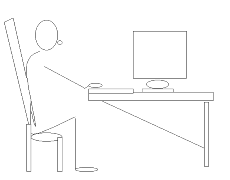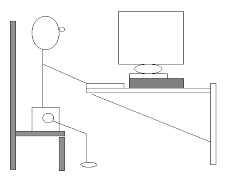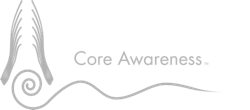Sitting at your computer for any period of time can be a very exhausting even painful experience. Fixating on a computer screen fatigues by overriding natural reflexes that coordinate and align posture. Besides the logical need to vary movement there are also ways to enhance your sitting time and minimize muscular tension.
Discovering your psoas muscle (pronounced so-as) and understanding its functions will help you make better decisions as to how to position yourself, the height and type of chair to use and the height of your desk, keyboard and monitor.
The psoas muscle is the core muscle of your body. Located closest to the gravitational forces, the psoas attaches to the 12th thoracic vertebrae (approximately at the level of your solar plexus) and to each of the lumbar vertebrae. The muscle moves through the pelvis and inserts into the inner thighbone called the lesser trocantor of the femur. The psoas muscle is a guy wire for the spine. It is also a hydraulic pumping system stimulating all circulatory systems, a psoatic shelf supporting organs and viscera and it is part of the fear reflex system preparing one to flee or fight. Sitting for long periods of time with a constricted psoas muscle depletes vital energy, curtails blood circulation, affects organ functioning and signals flee/fight reflex thus draining the adrenals and immune system. It’s health and suppleness affects every level of well being.

Typical Work Station (Incorrect)
To be stable and balanced while sitting in a chair the pelvis must be firmly placed and the psoas free to function properly. Bones give form and structure to your body. Balanced and in relationship one to another they support weight. Muscles move the bones. To sit effortlessly involves little muscular effort when your bones are optimally positioned. If the bones are not stable then muscular tension is substitute to create balance and the psoas muscle will be engaged inappropriately to stabilize the skeletal structure. Freeing your psoas muscle while sitting helps not only structural tension but also helps to maintain fullness of breath, good visceral and organ functioning and alert but relaxed awareness. Keeping your psoas released centers you deep within your core.

Stable Work Station (Correct)
Here are several tips to help you free your psoas:
Sit on a Flat Chair
Most chairs are not designed for sitting rather they are designed for appearance and for stacking. Ergonomically designed chairs are often just band-aid efforts to release tension that is already created from poor positioning. Many of the ergonomically designed chairs do not solve the problem where it originates.
When selecting a chair, notice the seat. Avoid bucket seats that form a hollow, as this does not offer your pelvis a firm solid placement. The pelvis is the keystone and the foundation for the rest of the skeletal system i.e. ribs cage, spine, head plus legs and feet. A stable pelvis supports the bones and frees the psoas muscles from unnecessary tension. The ischial tuberosities commonly known as your sits bones located at the base of your pelvis helps position the pelvis and torso. A chair needs to have a solid base of support for the tuberosites to balance and rest upon. Choose a chair with a firm flat seat. If your chair has a hollow or bucket type of seat modify the chair using a firm solid pillow or folded blanket placed in the hollow.
Sit with Your Weight in Front of Sits Bones
Many people sit behind the pelvic sits bones (ischial tuberosites) curling the pelvis under thus rounding the lower back and causing the neck and head to forward thrust. If you do not sense your sits bones than find them with your fingers. Lift up your buttocks and pull your glut (butt) muscles away behind you, then sit down slightly in front of the round bones (you can feel that are under your buttocks).
Sitting with your weight in front of the ischial tuberosites helps to give your pelvis stability thus supporting the arm, wrists and fingers perform motion necessary for typing. Isolated contracted arm movements make typing effortful. Gaining support through your pelvic core lets the support extend up through your core and out through your fingertips.
Sit with Your Hip Sockets Higher Than Your Knees
Your hip sockets need be higher than your knees for your psoas muscle and hip sockets to stay released rather than compressed. A stable pelvis frees the psoas muscle and keeps the hip sockets released. Compressed hip sockets cut off blood circulation to the legs and feet and can cause or aggravate sciatic nerve pain and muscular cramping. Choose a chair height that lets your hip sockets (located on each side of your pubis bone) to be slightly higher than your knee. A slanted hard foam cushion may help open the hip socket. A stool can also be used. The height of the stool or chair must let your pelvis be stable and supported with spine and head balanced on top.
Keep Your Feet on the Floor
Although changing leg positions can be very helpful in reducing the fatigue that comes with stillness its helpful to have your feet placed firmly on the ground. Doing so provides an energetic grounding as well as aiding structural stability. The nerves of the feet help stabilize and co-ordinate posture. Energetically the psoas muscle is the grounding wire of the human electrical system. This energy is translated from the psoas through the legs and needs to be received into the ground. Staying grounded helps reduce fatigue.
People often ask about the benefits of kneeling stools for sitting at desks. Kneeling stools do not allow the feet to be grounded (as the feet are not touching the floor). It is through the nerves in the bottom of the foot that we receive somatic and energetic information and support. Kneeling chairs increase stress in the knees, where tension may already be manifesting.
Keep Your Jaw Loose
The jaw and pelvis relate to each other. When one is tight or locked in tension the other will also express tension. Sensing the pelvic floor will release tension in the jaw and vice versa.
Once you have a good chair begin to modify the height of the table so that you do not lean over or reach up to type. Be sure your workstation allows your arms to hang loosely from the shoulder girdle when typing on the keyboard. In other words you do not want to use unnecessary tension to lift the arms or lean over to type. The wrist and fingers are in a neutral position.
Next, position the monitor to be high enough that your eyes look directly at the screen while working. Be sure the monitor is high enough so your eyes look directly ahead rather than down. Lifting the monitor to a height that supports the head/neck righting reflexes is essential for maintaining stability. The proper height encourages your body to follow your eyes and head looking straight ahead when typing rather than collapsing downwards.
While typing shift your weight forward and back (a small rocking motion) through the hip sockets (rather than bending at the waist or collapsing the head and shoulders). Letting the whole torso move together reduces shoulder, neck and back fatigue. Keep your typing material in front of you. Doing so helps you avoid locking your head down while typing.
A constricted upper psoas instead of freeing the rib cage and elongating the spine collapses the chest and hyper-extends the lumbar spine. Using a back pillow for the small of the back or the neck to relieve back pain (a result of a hyper-extended spine) is only another band aid approach to a much deeper problem, a constricted psoas. Learning to release your psoas through the constructive rest position (see The Psoas Book by Liz Koch for more detailed information) and other sensory awareness exercises will bring more long-term results.

